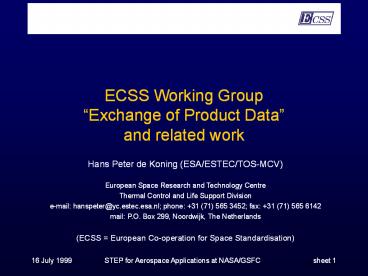sheet 1 - PowerPoint PPT Presentation
Title:
sheet 1
Description:
... definition, concurrent engineering, etc. ... ECSS-E-40 - Software Engineering (only on CI level) ECSS-E-60 ... data for automotive mechanical design ... – PowerPoint PPT presentation
Number of Views:46
Avg rating:3.0/5.0
Title: sheet 1
1
ECSS Working GroupExchange of Product Dataand
related work
- Hans Peter de Koning (ESA/ESTEC/TOS-MCV)
- European Space Research and Technology Centre
- Thermal Control and Life Support Division
- e-mail hanspeter_at_yc.estec.esa.nl phone 31
(71) 565 3452 fax 31 (71) 565 6142 - mail P.O. Box 299, Noordwijk, The Netherlands
- (ECSS European Co-operation for Space
Standardisation)
2
Why need a WG and standard Exchange of Product
Data ?
- Efficient and effective electronic exchange of
product data is considered a key enabler
forfaster/better/cheaper development of space
products - Long term, tool-independent archiving of product
data is also needed in many space programmes - European space community (industry and agencies)
need a frame of reference in order to standardise
on protocols for the communication of product
data
3
Brief background of the WG
- 1994 ESA started developing STEP-based data
exchange standards (in co-operation with CNES) - At first focusing on thermal analysis model
exchange - 1994 to 1998 interest broadened across
disciplines - Electronic product definition, concurrent
engineering, etc. - Growing maturity of STEP / more capable CAx tools
- May-98 first informal meeting industry and
agencies to assess need, support, Draft Terms of
Reference for a WG - Feb-99 Officially installed as ECSS WG E-10-07
4
Tasks of the WG
- Review of existing international product data
exchange standards and their suitability for use
in space projects - focusing primarily on STEP - Identification of areas for which adapting /
developing space-specific STEP-based standards is
cost-effective - recommendation and promotion of
further actions - Production of an ECSS standard for the exchange
and archiving of product data in space projects - Including guidelines concerning the
implementation / use of the standard
5
Standardisation approach (1)
- ECSS E-10-07 is part of E-10 System Engineering
- Addresses exchange via neutral standards (1)
between different tools of one discipline(2)
between tools of different disciplines - Archiving is considered an application of (1)
6
Standardisation approach (2)
- Targeted disciplines
- ECSS-M-40 - Configuration Management
- ECSS-M-50 - Information / Documentation
Management - ECSS-M-70 - Integrated Logistic Support
- ECSS-Q-70 - Material, Mechanical Parts
Processes - ECSS-E-10 - System Engineering
- ECSS-E-20 - Electrical Electronics
- ECSS-E-30 - Mechanical (including thermal)
- ECSS-E-40 - Software Engineering (only on CI
level) - ECSS-E-60 - Control Systems
- ECSS-E-70 - Ground Systems Operations
7
Standardisation approach (3)
- E-10-07 is an umbrella standard
- Specifies which standard to use for what PDE
situation - Makes reference to existing international
standards - Primary focus on ISO 10303 (STEP)
- Adds guidelines / best practices on how to use
the standard - Designed for tailoring by individual projects
- Only file-based exchange in scope for first
release
8
Standardisation approach (4)
- Identified candidate STEP(-based) standards
- AP 202 Associative draughting
- AP 203 Configuration controlled design
- AP 209 Composite and metallic structural
analysis and related design - AP 210 Electronic assembly, interconnect and
packaging design - AP 212 Electrotechnical design and installation
- AP 214 Core data for automotive mechanical
design processes - AP 232 Technical data packaging core information
and exchange - AP 233 Systems engineering application protocol
- STEP-TAS AP Thermal Analysis for Space (ESA)
- STEP-NRF AP Network-model Results Format (ESA)
- STEP-PRP AP Propulsion Systems (CNES)
9
Requirement for tailoring
- It is very unlikely that in practice such a
standard can be applied as a whole to a project - It shall be possible to use the standard as a
contractual document in a programme or projectby
declaring a subset of applicable clausesto
specify the data exchange protocolsthat shall be
used between parties - Requirement for tailoring is recognised across
all ECSS standards
10
ECSS E-10-07Initial core requirements
specification
- A extensive list of structured 4-element
requirements - To exchange datafrom a ltsource_disciplinegt
representation - to a ltdestination_disciplinegt representation
- for the purpose of transferring ltkind_of_datagt
- the ltexchange_standardgt standard shall be used.
- For long term archiving the requirement as for
exchange within one discipline shall be used - Identical ltsource_disciplinegt and
ltdestination_disciplinegt
11
Example excerpt of initial requirements
specification (1)
12
Example excerpt of initial requirements
specification (2)
13
Status/schedule of WG
- 17 members (1/3 from agencies, 2/3 from industry)
- 3 working meetings held
- Terms of reference written and agreed
- First working draft produced
- Currently in review and comment loop
- Proofs difficult to actively involve industry in
production of the standard (as always with long
term benefits) - Goal is first release of standard early 2000
14
Related work
- Since 1994, 3 STEP-based APs have been developed
by European space community - STEP-TAS Thermal Analysis for Space (ESA)
- STEP-NRF Network-model Results Format (ESA)
- STEP-PRP Propulsion (CNES)
- TAS and NRF developed as companion APs together
with common Integrated Application Resources - Space Domain
- Definition and Results of Analysis, Tests and
Operations - Thermal Analysis
15
Status STEP-TAS STEP-NRF
- Integrated Application Resources and
APsavailable in fully compliant ISO TC 184/SC 4
format - Full programming libraries available
- With documentation (PDF, HTML)
- C and FORTRAN APIs
- STEP-TAS CC1 converters implemented in
- ESARAD 4.1 (released June 1999)
- THERMICA (release of 1999-Q3)
- Limited prototypes TRASYS and TSS (with NASA-JPL)
- STEP-NRF prototypes at Intespace and EdF
16
Future work related to STEP at ESA
- Continued implementation of STEP-TAS
- Further development of STEP-NRF
- AP203 (CC1,4,5,6) import facility in ESARAD
- Supports import of CAD product structure and
shape - Will include support for NURBS in ESARAD model
- Idea for CAD-to-Analysis tool based on AP203
17
Idea AP203-based CAD-to-Analysis tool
- UNIX type pipe of filters
- Open API
- Online visualisation































